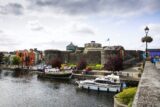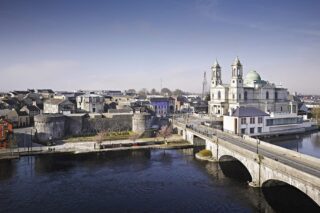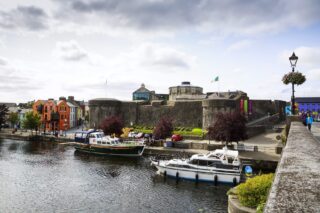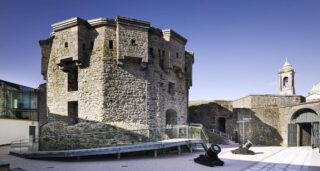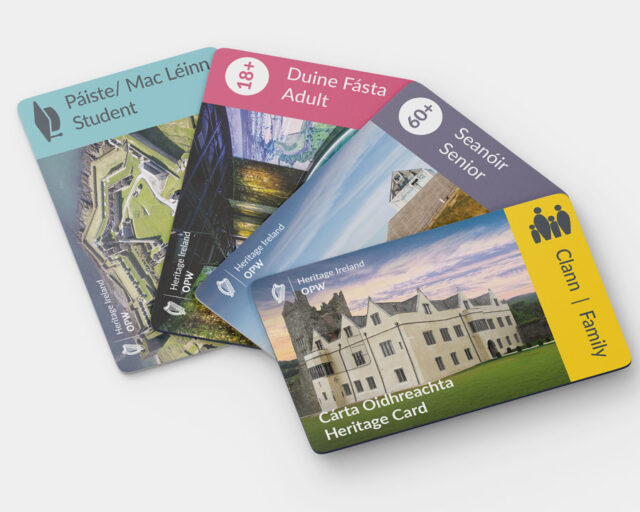Notice
Athlone Castle is a state-owned National Monument in the care of the Office of Public Works
WARNING: It should be noted that these sites are unguided and a level of care and caution should be maintained during all stages of your visit. The Office Of Public Works (OPW) will not be held responsible for any damages, injuries, or losses that occur
Athlone Castle
Athlone Castle was built as a Royal Castle in 1210 to control an important fording point over the River Shannon. The Anglo-Norman stone castle was built on lands originally granted in 1200 to Geoffrey de Constentin. In 1215, King John granted a mandate to ‘Godfrey [Geoffrey] de Constentin to safely keep the castle of Aslon [Athlone], as he previously kept it’. The present structure traces its foundation to John de Grey, Bishop of Norwich and Justiciar of Ireland, who commenced construction of Athlone castle in 1210. In this year, King John of England ordered the Bishop to erect three castles in the province of Connaught.
The stone castle of Athlone was built on monastic lands belonging to the priory of Saints Peter and Paul, situated to the south. Work on the castle is sporadically recorded during the 13th century. In 1270-72 the Exchequer paid 5 marks in wages to ‘Nicholas of Gloucester, carpenter of the castle of Athlone’. In 1273-4, the justiciar, Geoffrey de Geneville, spent over £3,500 on various projects including ‘repairs of the castle and houses of Athlone’. Between 1286 and 1290 the Exchequer made a payment to ‘Geoffrey Brun, clerk, of £300, to be spent on fortification of Athlone. It is likely that much of the surviving medieval fabric of the castle, particularly the river wall with its three-quarter-round towers at each angle dates to this period. Parts of the castle had fallen into neglect by 1305 and repairs were carried out in 1306 by Richard de Exeter, constable of Roscommon Castle.
The Annals of St. Mary's, Dublin, note the burning of the castle and town by Ruaidri O Conchobhar in 1315 but the castle was not captured. Little is known of the castle in the later 14th and 15th centuries, although it is clear that it was frequently in Irish hands until recovered by the Crown in 1537. In this year it was recorded that the ‘castle of Athlone, standing upon a passage betwixt Connaught and these parts, is recovered, which has long been usurped by the Irish’. Thereafter the castle remained in English hands serving as the residence of the Presidents of Connaught after 1569.
In 1547, the Annals recorded that the ‘castle of Athlone was repaired by the English, namely, by William Brabazon, the King's Treasurer in Ireland. During the Sieges of Athlone in 1690-91 the external walls and towers came under heavy fire and subsequently destroyed by lightening in 1697. From 1799 to 1815 the castle was considerably remodelled, modernised and adapted. In 2012 Athlone Castle reopened to the public.
Visit Historic Environment Viewer for more information on Athlone Castle
Protect our Past - Click here to read about the importance of protecting our country’s unique heritage sites
This national monument is protected in accordance with the National Monuments Acts 1930 to 2014
Gallery
Nearby sites to visit
Clonmacnoise Monastic Site
A spectacular monastery on the banks of the river Shannon
Approx. 11.1 km from Athlone Castle
Corlea Iron Age Roadway and Visitor Centre
A pathway into the past
Approx. 22.0 km from Athlone Castle
Roscommon Castle-South West Tower
A dramatic and imposing thirteenth Century Norman Castle
Approx. 28.7 km from Athlone Castle
Portumna Castle and Gardens
Seventeenth-century splendour on the shores of Lough Derg
Approx. 41.7 km from Athlone Castle
Rathcroghan Visitor Centre
Follow in the footsteps of Queen Medb at Connacht’s ancient capital
Approx. 44.6 km from Athlone Castle
Roscrea Castle, Gardens and Damer House/Black Mills
A place of medieval might and eighteenth-century elegance
Approx. 52.9 km from Athlone Castle
